|
How I
Learned the Nuts and Bolts of a Good Day’s Work.
Memories of an
Apprentice Anthony R. Andrew
After receiving my exam results in
1962 and leaving Short Heath Secondary Modern, I decided
I would like to be a draughtsman, the reason being that
I had achieved a distinction in that subject. I went on
a job search during August to many local factories but
failed to get a job. I was beginning to get
disillusioned and fed up with being rejected when my
mother suggested I enrol for a college course, which in
her words meant that "I wouldn't end up in a factory".
I enrolled for a full time
pre-engineering course (electrical bias) and spent an
enjoyable time learning new subjects and doing practical
electrical tasks. I passed the course in August 1963 and
left Walsall and Staffs Technical College to find a job
but "not in a factory". After writing off for many jobs
to complement my new knowledge and school exam results,
I failed to achieve employment as a draughtsman so the
only route left was to try for an apprenticeship in
engineering. My quest for apprenticeship status began at
John Harpers, Willenhall, then Wilkins & Mitchell,
Rubery Owen, and Easiclean, but to no avail. Finally I
was sent from the youth employment service to Charles
Richards Nuts & Bolts Ltd. |
|
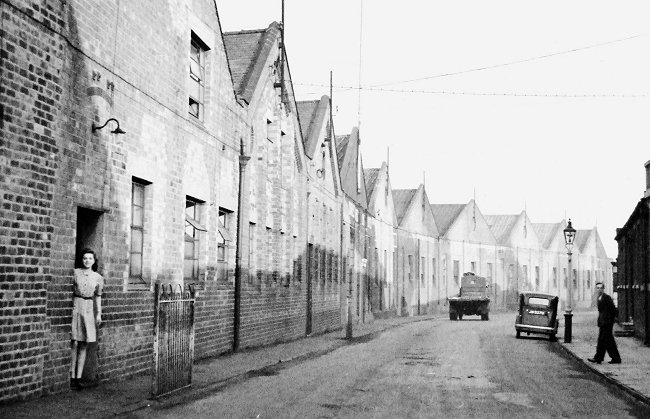
Charles Richards' Imperial Works
in Heath Road, Darlaston in the 1930s. |
|
Massive
After my interview at Charles
Richards I was offered an engineering apprenticeship. My
father was asked to attend the second interview to sign
my indenture documents. After the formalities were
completed I was welcomed to Charles Richards Nuts &
Bolts Ltd for the next five years. It was very strange,
that first day at Richards's. The first feeling on
entering the small wooden door off Heath Road was
"Bloody hell, what have I signed up for?" (and wishing,
in the back of my mind that I had worked harder for my
Eleven Plus). We were in the Black Forging Department,
with all sorts of massive, noisy, hot machines, banging
and forming red hot steel metal bars into nut and bolt
shapes.
We (the apprentices) nervously
followed the chief instructor past workers who were
feeding furnaces, loading power presses with steel
billets, pushing trucks, pulling trucks and feeding
automatic forging machines with long, round bars. The
workers stared at our keen young fresh faces with a look
that said "Why do you want to work in a place like
this?" The main things you noticed upon this first
"tour" were the noise, dirty floors, old doors and steel
windows with glass that was filthy dirty, due to the
smoke, heat and sweat of decades of hot metal
manufacturing through two world wars and numerous
recessions. There was also that "factory metal smell"
that was always synonymous with any steel bashing
establishment of that era.
We arrived at our destination,
which was the apprentice training school situated within
the "bowels" of the fitting and machine shops. The
department was perched over a canal basin, which was to
become very useful during the first year of training.
After the formalities of health and safety instructions,
time planning sheets and general works information, we
were asked to introduce ourselves to each of the other
ten apprentices who we would be working with for the
next five years - all strange faces but friendly enough,
some serious, some nervous, some funny and although some
were tall and some were small, we all looked the same in
our new baggy boiler suits. |
|
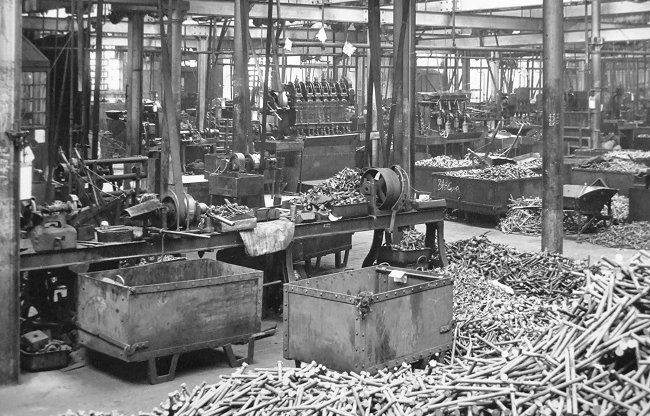
Part of the bolt production line. |
|
After a few weeks induction we
began our training schedule beginning with machining of
components to engineering drawings in the training
school. This was when we realised the canal basin
outside the window was to prove very useful.
If a particular part was scrapped,
usually due to chatting to your mates and leaving
autofeeds on, it could be ejected through the window
into the cut when the instructor was out of the
department. The main thing was to chuck it as far as
possible to avoid a big pile of rusting metal parts
which was up to the canal surface, this being left by
decades of apprentices throwing their scrap in the cut.
The first year was OK, although we
had to attend college for one day a week, which was a
bit of a shock. But unlike school, we began to be
treated like adults. Once we got used to going to
college it was great - a day off work. It was this year
I got my first scooter (a Vespa) which gave me freedom
to zoom around the locality with my new apprentice
mates, going to coffee bars and the pictures.
Mending
After the first year of training
and college tuition it was time for us to be allocated
to various departments in the company. My first move was
to the maintenance area in the New Imperial Department.
This was my first chance to obtain new skills of machine
repair and servicing to achieve continuity of nut and
bolt production.
This area was "over the road" and
seemed a million miles away from the training school. I
felt like I was a proper worker, assisting the fitters
and mending machines. The people who worked on the shop
floor were the salt of the earth and the maintenance
fitters soon accepted me as the new boy and became my
mates. |
|
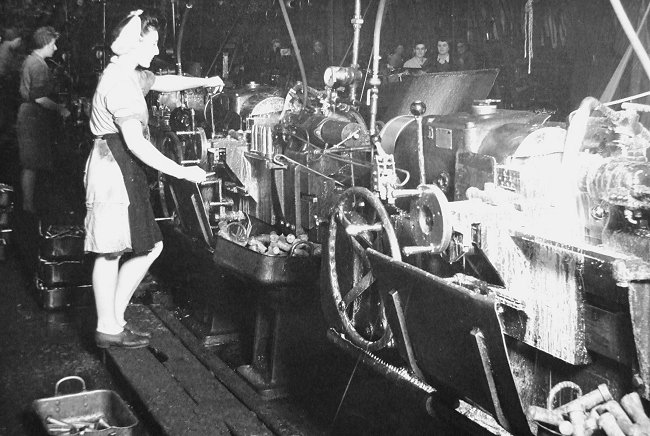
Another part of the bolt
production line. |
|
Many things happened during my six
months in this area. Once, when I was on a lunch break,
I decided to toast my sandwiches on a small electric
fire with a home-made wire fork. The work that morning
had been particularly arduous and while doing my
toasting I fell asleep and my fork touched the open
element waking me up with an electric shock up my arm. I
tried to let go but at first couldn't. After a lot of
yelling and shaking I finally broke loose, ran outside
and dived in a pile of snow, which being January had
fallen the night before. After lying there for five
minutes or so I looked upstairs to big "G" and said
thanks. Fortunately it was only 240 volts and not 415
volts. The rest of my time in this area was enjoyable
and completed with no more "shocking" moments.
The next move was back to the
fitting shop where I would be working with the machine
tool fitters for six months, stripping down and
rebuilding various machines used in nut and bolt
production. I immediately enjoyed it in this department
and felt at home with the tasks I was asked to do. The
machine tool fitters were great blokes who were mostly
friendly and helpful to the "new apprentice". There was
Fred Hampton, Jack Williams, Charlie Bailey, Jimmy
Rogers, Bill Griffiths and Arthur Bettley. Some of these
were workers who had helped keep the company production
going through the war and since then I have often
wondered if their efforts and that of other similar
workers were appreciated by the government of the day,
which contributed to the defeat of Hitler through their
hard work.
Having begun my six months working
in the fitting shop I found out some of my fellow
apprentices were in there as well, which was great and
meant we could have a few laughs during the following
months, which we did. The first thing you were told by
the foreman was to listen to what you were told by the
fitters and learn from them. I was assigned to work
mainly with Fred Hampton who, I had been told, was one
of the best engineers in the shop. Fred was very
instructive and taught me all the skills he could in six
months. |
|
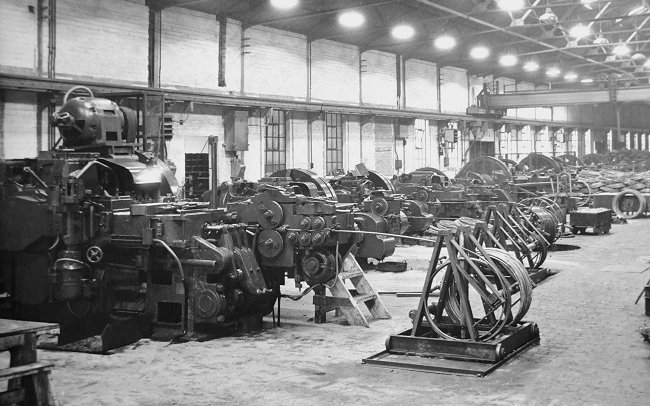
Large diameter coils of steel are
threaded into machines, possibly to be cut and threaded
for studs. |
|
I moved on from the fitting shop
for six months in the laboratory. This was the
department that tested the quality of the products that
were "heat treated" for greater tensile strength and
quality. The lab was hidden away up an alleyway by some
toilets and upon first entering, it was reminiscent of
the science room at school. The main machine was for
tensile testing of bolt samples taken from the heat
treatment process, which were then turned down on a
lathe to a defined cross sectional diameter before being
fixed in the machine tooling and pulled under hydraulic
pressure until it fractured. The result was then
recorded and logged before testing the next sample.
At first this was very new and in
those days "hi tech", but after a few hours of "bosting"
bolts it became extremely boring. After my six months
confinement in this place I was finally transferred back
to reality into the Bright Shop maintenance area. Great!
A chance to get my hands dirty and have a laugh with
some of my mates. The fitters in the shop were down to
earth and hard working. The chargehand was George Lees
and the fitter was Bill Foulkes. In this department you
were taught to think for yourself and get on with the
jobs.
Overtime
Any problems were soon rectified by
Bill or George, who were always willing to help and
teach you all the tricks of the trade. Day-to-day
maintenance was supplemented by Saturday morning
overtime, which came in very useful for a chap who now
had an A35 van to support. I was then moved back to the
fitting shop to do six months of machining. Having spent
the majority of my time in this area I was immediately
at home with my surroundings and began, after initial
instruction, to work on the planning machine. |
|
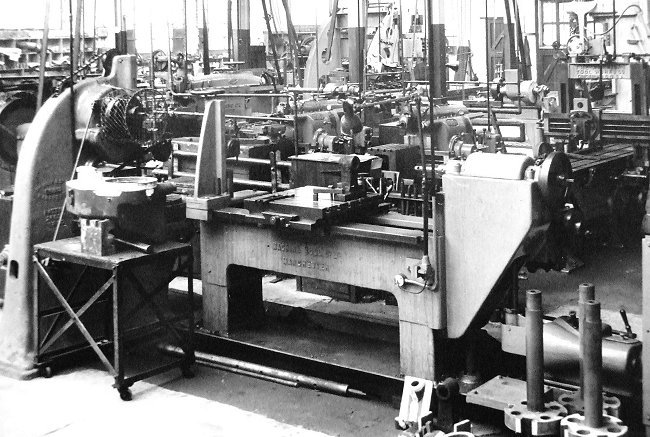
The corner of a machine shop,
possibly in the maintenance department. |
|
The time had come for my next
training period, this time in the Drawing Office, the
move I was looking forward to, although I was a bit
nervous of the works engineer.
The next Monday I started at 8.30
instead of 7.30, wearing my best suit and shiny shoes
and reported to the chief draughtsman, Les Foulkes. He
was another nice bloke who had worked his way up from
the shop floor. I was introduced to the manager, works
engineer, and the girl who was the drawing tracer and
another girl who was the junior tracer. The change from
shop floor to an office environment was amazing. You
were treated like a person, not just another worker, and
I felt quite at home.
My first task was to learn how to
print off large drawings on the ammonia print machine,
then to trim them on the guillotine. This was OK, but
sometimes you did get a lungful of ammonia which
certainly cleared your sinuses.
The following months passed with
great memories. The office was a happy place, with Les
having his daily apple, always peeling it then slicing
it to eat, followed by a cigarette. This was usually
smoked in conjunction with the junior tracer, who also
smoked and used to launch a fag over the drawing boards
to reach Les at the back. This was repeated in reverse
at tea break. Being in the drawing office was another
world from the factory floor and if I had to go out to
take some measurements for a drawing my mates would say
"yow'm dressed up a bit posh, ain't ya". I would reply
that they would have to "dress up" as well when they
went into the Drawing Office.
While I was there we had loads of
good times. I hoped that I could stop in there and when
an interesting task came up I thought I might be asked
to stay on permanently.
This was the time in the mid-1960s
when nuts & bolts companies were changing their logos to
refer to "fasteners" instead of the old fashioned "nuts
& bolts". My directive from the works engineer was to
modify all existing signs and wall letterings. The next
few weeks I spent climbing ladders, painting out "nuts &
bolts" and painting in "fasteners". I also had to draw
all the walls to scale, showing every brick and every
letter change for contractors to do the external
lettering modifications. The engineer was satisfied with
my efforts and I was hoping he would offer me a job in
office, but sadly the offer never came.
It was a turning point in my career
and I knew my ambition to be a draughtsman would never
be fulfilled, at least not at Charles Richards. Maybe it
was that secondary modern stigma again. I'll never know.
The powers that be then transferred me to the General
Toolroom for three months, which was noisy and full of
comedians and jokers, all great working people. The work
was interesting but not really what I wanted so after
three happy months I went back to the fitting shop to
finish my apprenticeship. |
|
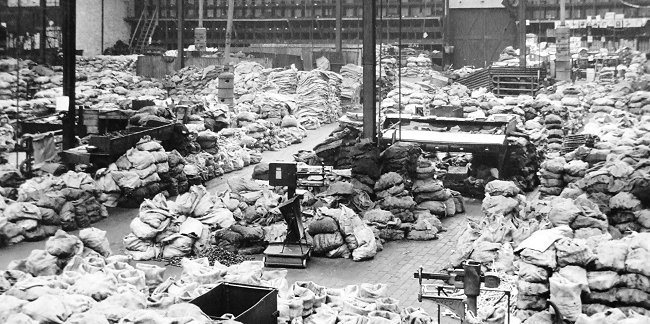
Part of the packing department. |
|
Working in the fitting shop was my
last placement before completing my training and I was
assigned to the machine tool bench, being given the vice
and bench area formerly used by Jack Williams, a top
class engineer who had recently retired. I had a lot to
live up to, but luckily it was next to my "mentor" Fred
Hampton, who was approaching retirement in the next few
years. Although I was still an apprentice I was given a
"proper job", machine rebuilding, the first one being a
"5/8" Van Thiel hot nut forging machine, which usually
took four to six months to complete.
Fred taught me the correct
procedures to begin a machine refurbishment. It began
with a general stripping down of parts from the main
machine body, each part having to be cleaned with
paraffin and rags, ready for inspection for wear and
replacement of bearings, fastenings, oil pipes etc. The
main body was then cleaned down.
Keepsake
There was a great feeling of
satisfaction six months later when the machine was
finished and ready for production. The best thing was
being presented with the first nuts produced on the
machine for a keepsake. As soon as one Van Thiel machine
went out another one was taken off production and
brought in to the shop for rebuild. This time I knew
what to do and got on with it. I was nearly a machine
tool fitter.
Life in the shop wasn't all work
and no play, we had many distractions from the daily
grind, especially at lunchtimes. In winter we had the
darts school in the welding shop, when we would all
become "Eric Bristows" for half an hour, throwing our
bespoke factory darts in a sort of in-house league. In
the summer we used to have a "kick about" in the loading
bay after going up "Darlo" to get some "orange" chips
from Middleton's chip shop. Most of us now had cars and
a new lunchtime venue was on the car parks where we
would suddenly become expert mobile mechanics.
Christmas festive celebrations were
always one big booze-up with the last day spent cleaning
up and generally housekeeping in the fitting shop with
an air of expectancy that we would be told we could all
finish at lunchtime, which always happened. When the
hooter went off there would be a stampede of apprentices
through the door to see who would be the first in the
pub, usually the Why Not pub. After the first hour or so
some of us would go "on tour" to a few more of the local
pubs, The Bush and The Glamour House. |
|

A few of the firm's many products. |
|
In August, 1968, the end of my
apprenticeship had arrived and one afternoon I was
called into the boardroom and presented with my
indentures by the managing director in the presence of
my training manager and supervisor. After a short speech
and a handshake I received them - not much of a ceremony
after all the grafting I had done in five long years.
I stayed on, having been "half
promised" promotion in a few years, but on reflection I
think it was a mistake to stay on because all I used to
hear was "you won't get promotion, because you are too
useful on the bench rebuilding machines", and they were
right. So after a further seven years as a machine tool
fitter, and becoming "part of the furniture" at Charles
Richards's, I decided to leave and get another job in
1975.
I feel privileged to have known the
people who were my workmates and friends in the 1960s
and early 1970s and who were hard working, dedicated
Black Country folk. My time as an apprentice taught me
to respect people and to do a "good day's work for a
good day's pay". |
|
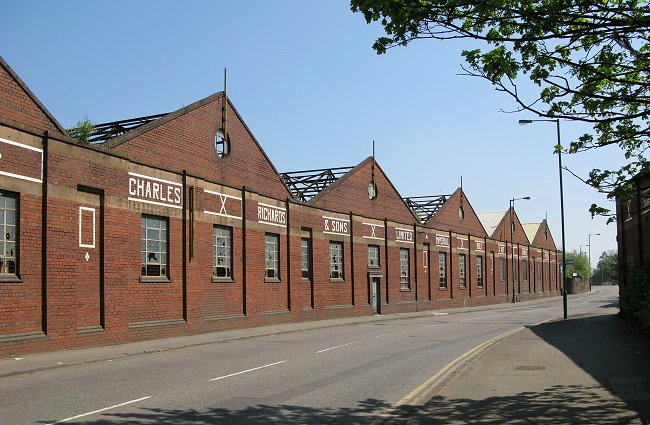
The remains of Imperial Works in
2008. |
 |
Return to
the
previous page |
|